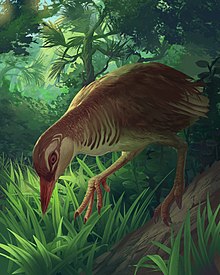Astolfo's rail
| Astolfo's rail Temporal range: Late Holocene
| |
|---|---|

| |
| Artistic reconstruction of Astolfo's rail, Gallirallus astolfoi, 2022 by Simone Giovanardi. | |
| Scientific classification | |
| Domain: | Eukaryota |
| Kingdom: | Animalia |
| Phylum: | Chordata |
| Class: | Aves |
| Order: | Gruiformes |
| Family: | Rallidae |
| Genus: | Gallirallus |
| Species: | †G. astolfoi
|
| Binomial name | |
| †Gallirallus astolfoi Salvador, Anderson & Tennyson, 2021[1]
| |
Astolfo's rail (Gallirallus astolfoi) is an extinct species of flightless bird in the Rallidae, or rail family. It lived in Rapa Iti, one of the Bass Islands in French Polynesia.
History[edit]
This rail species was described in 2021 from a subfossil bone collected in 2002 by Atholl Anderson[2] at the Tangarutu Cave site on the island of Rapa Iti in French Polynesia.[1] Occupation of the cave likely dates back to between 1400 and 1600 CE.[3] The species likely became extinct after human settlement on Rapa Iti.
Etymology[edit]
The specific epithet honors the fictional character Astolfo, who is one of Charlemagne's paladins in the Matter of France.[1] In the epic Orlando Furioso, by Ludovico Ariosto, Astolfo becomes trapped on a remote island because of the sorceress Alcina.
See also[edit]
References[edit]
- ^ a b c d Salvador, Rodrigo B.; Anderson, Atholl; Tennyson, Alan J.D. (2021). "An Extinct New Rail (Gallirallus, Aves: Rallidae) Species from Rapa Island, French Polynesia". Taxonomy. 1 (4): 448–457. doi:10.3390/taxonomy1040032.
- ^ "Astolfo's Rail, Gallirallus astolfoi". Collections Online. Retrieved 30 May 2022.
- ^ Anderson, Atholl; Kennett, Douglas J.; Comte, Eric (2012). "The prehistory of Rapa Island". Terra Australis. 37: 247–256.
